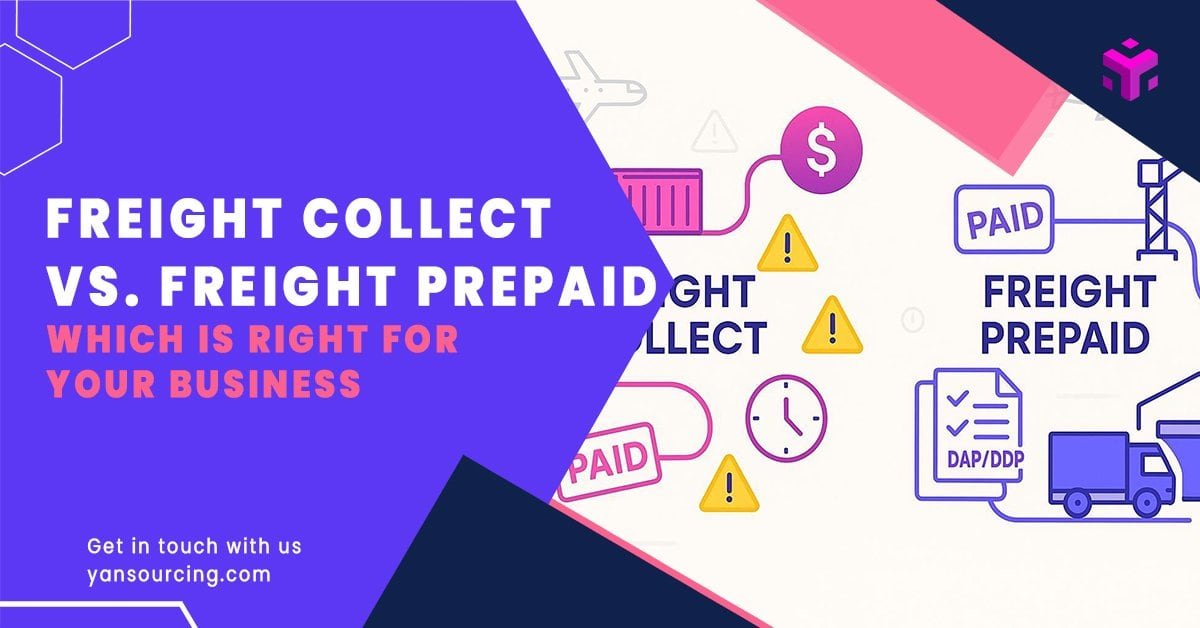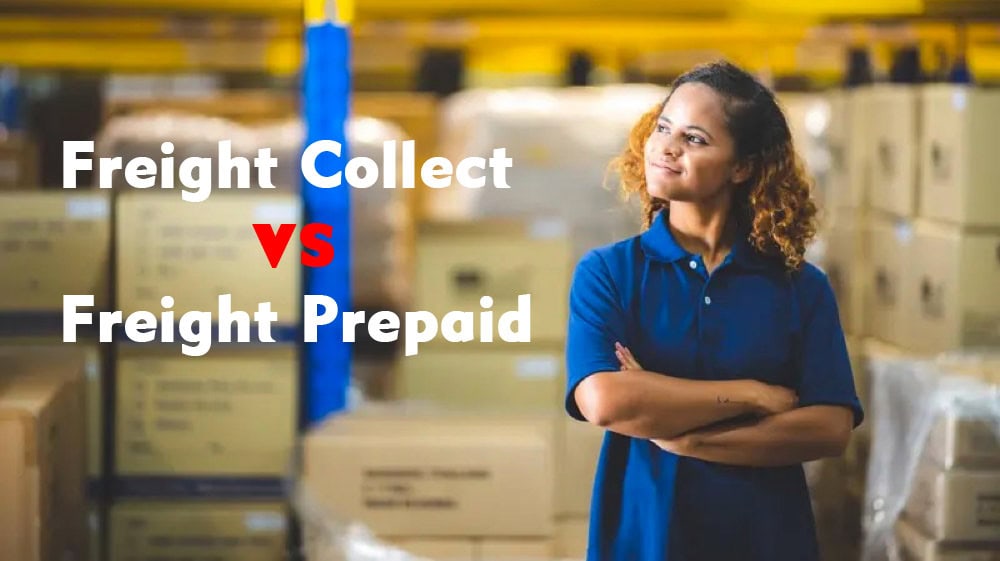
Making the wrong call between Freight Collect and Freight Prepaid can turn a straightforward shipment into a costly lesson—especially for e‑commerce brands on tight launch timelines.
This guide translates the two payment terms into practical outcomes: who pays what, when your cash leaves the account, how fast cargo gets released, and where hidden fees lurk.
We’ll map the choices to Incoterms, transport modes (LCL/FCL/Air), and common e‑commerce scenarios. We’re not declaring a universal “winner”; we’ll group recommendations by use case.
Quick comparison: what changes with Collect vs. Prepaid
| Dimension | Freight Collect | Freight Prepaid |
|---|---|---|
| Who pays main freight | Consignee (buyer) on arrival | Shipper (seller) at origin |
| Cash flow timing | Payment on arrival; may need local credit/account | Upfront before departure; more predictable landed cost |
| Control of carrier/forwarder | Usually buyer | Usually seller (or seller’s forwarder) |
| Release risk if unpaid | Higher: release can be held until charges paid; demurrage/storage may accrue | Lower: freight is settled; destination pays mainly customs/duties |
| Destination fee exposure | Higher risk of surprise local charges (D/O, THC, CFS) | Lower surprise risk when aligned with DAP/DDP |
| Best for | Mature buyers with strong destination agents and credit | New importers, FBA/Shopify, door-to-door and DAP/DDP flows |
Notes:
- Carriers generally require the billed party to have a valid account; if the receiver refuses or can’t pay, charges can revert to the shipper. FedEx states that shipments must be either prepaid or collect—no partial splits—per its 2025 rules tariff, and recipient billing requires a valid account; if refused, charges revert to sender, per its conditions of carriage (see the 2025 FedEx FXF 100 Rules Tariff and FedEx Conditions of Carriage). UPS likewise notes that if a receiver/third party designated to pay does not pay, the shipper is liable, per the 2024 UPS Terms and Conditions of Carriage.
Why Collect often creates problems (and where it still fits)

In theory, Collect lets buyers choose their destination agent and pay locally. In practice, the destination side can be where costs and delays pile up.
Common pitfalls we’ve seen in the field:
- Non‑transparent destination charges: Delivery order (D/O) and terminal handling charges (THC) appear at arrival and must be paid before release. Carriers and terminals publish these as local fees, but visibility pre‑shipment is limited. See Maersk’s explanation of the delivery order process and fees in its 2024 article on the self‑service delivery order and its notices for OHC/DHC (THC) adjustments such as the 2024 Finland THC notice. Hapag‑Lloyd also outlines THC and local cost types in its 2024 guide to sea freight rates and cost types.
- Release delays when payment isn’t immediate: Under Collect, the carrier/agent can withhold release if the consignee hasn’t paid. This quickly triggers storage or demurrage. The U.S. Federal Maritime Commission’s 2024 Final Rule tightened billing transparency for demurrage/detention (invoices and timelines), but charges can still accrue with delays; see the FMC’s 2024 announcement on the Final Rule for demurrage and detention billing practices.
- Credit/account issues at destination: Smaller consignees may lack accounts or credit with the carrier/terminal, forcing prepayment workarounds that slow clearance. FedEx and UPS both condition recipient billing on valid accounts; otherwise liability reverts to shipper (see FedEx Conditions of Carriage and the 2024 UPS T&Cs).
Real case (Yansourcing internal, 2024): A mid‑sized U.S. home goods buyer insisted on Collect. At Los Angeles, they were billed about $1,800 for D/O plus storage penalties—more than the ocean freight. Clearance delays pushed their Amazon launch 12 days late, missing the sales window.
Where Collect can still make sense:
- FCL with a stable destination forwarder: If you have negotiated port handling, trucking, and a credit line, Collect under FOB/CFR can work. In our internal experience (2023–2025), FCL Collect delays can stay under ~15% when the destination agent relationship is strong (internal benchmark; exact outcomes vary).
Why Prepaid often runs smoother (and what you trade off)

Prepaid requires cash out earlier, but it consolidates decision‑making and typically reduces destination‑side surprises—especially under DAP/DDP.
Advantages we commonly observe:
- Predictability and fewer disputes: The main linehaul is settled before sailing. Destination parties focus on customs/duties and arranged last‑mile. DHL’s 2024–2025 explainers summarize why DDP reduces surprise costs and delays in cross‑border e‑commerce by having the seller pay duties/taxes up front; see DHL’s overview of DDP vs DDU.
- Better network rates via experienced forwarders: Across our programs, negotiated network rates through partner forwarders often beat ad‑hoc destination quotes (we typically see 8–12% savings vs buyer‑organized local forwarders; internal observation, 2023–2025).
- DAP/DDP aligns incentives: Incoterms 2020 clarifies who pays what. Under DAP, the seller handles carriage to the named place; under DDP, the seller also handles import clearance and duties. See the ICC’s Incoterms overview and ICC Academy’s explainer on DAP vs DDP in Incoterms 2020 and the ICC’s page on Incoterms rules.
Example (Yansourcing internal, 2024–2025): A European Shopify seller using DDP + Prepaid for small‑parcel air saved about 9% total freight versus Collect, cleared 3–4 days faster on average, and avoided peak‑season storage.
Trade‑offs:
- Higher upfront payment: You fund freight earlier, which affects cash flow. Many brands accept this to avoid unpredictable destination charges and missed launch dates.
Incoterms 2020: who pays what (and how payment terms align)
Incoterms don’t directly set “Collect” or “Prepaid,” but they define the handoff point, risk transfer, and cost allocation. Your billing choice should align with the chosen Incoterm.
| Incoterm | Seller pays | Buyer pays | Typical payment term alignment |
|---|---|---|---|
| EXW | Minimal (goods at seller’s premises) | Main carriage, insurance, destination handling, import clearance/duties | Collect bias (buyer organizes) |
| FOB | Origin handling and delivery onboard vessel | Main carriage, insurance, destination handling, import clearance/duties | Collect bias (FOB + Collect common) |
| CFR | Main carriage to destination port | Insurance (optional), destination handling (THC/D/O), import clearance/duties | Mixed; often Prepaid for ocean freight only |
| CIF | Main carriage + minimum insurance | Destination handling (THC/D/O), import clearance/duties | Mixed; freight prepaid, destination charges still buyer |
| DAP | Main carriage to named place; destination handling up to delivery point | Import clearance/duties | Prepaid bias |
| DDP | Main carriage, destination handling, import clearance/duties | Typically nothing at delivery | Strong Prepaid bias |
Sources: ICC’s 2020 Incoterms overview and ICC Academy explainers for DAP vs DDP and CIP/CIF insurance obligations. Remember: even under CFR/CIF, destination local charges (THC, D/O) usually fall on the buyer unless otherwise negotiated.
Mode matters: LCL, FCL, and Air/Express
| Mode | Payment term tendency | Why |
|---|---|---|
| LCL (CFS) | Prepaid bias | More line items at destination (CFS deconsolidation, documentation, storage if beyond free time) can cause surprises with Collect. Maersk explains CFS vs CY flows in 2024: CFS/CY logistics. |
| FCL (CY) | Depends on partner network | With a strong destination agent and negotiated tariffs, Collect under FOB/CFR can be efficient. Without that, Prepaid reduces friction. |
| Air/Express | Mostly Prepaid/DDP | Air capacity is typically paid upfront; DDP avoids consignee‑on‑arrival duty/tax surprises and speeds door delivery (see DHL on DDP benefits). |
Internal experience benchmarks (Yansourcing, 2023–2025; indicative only):
- Collect LCL: ~30% incidence of extra charges/delays.
- Prepaid LCL: <10% fee disputes.
- FCL Collect: with stable destination agents, delay rate <15%.
Decision flow you can apply today

- What’s your experience and network strength?
- New importer or no destination agent/credit → Favor Prepaid (DAP/DDP alignment).
- Mature buyer with negotiated destination tariffs and credit → Collect can work (FOB/CFR), especially for FCL.
- What’s your transport mode?
- LCL → Bias to Prepaid to avoid CFS surprises.
- FCL → Depends on your partner network; otherwise Prepaid for predictability.
- Air/Express → Mostly Prepaid/DDP for smoother door delivery.
- Which Incoterm fits your risk and cost allocation?
- Want fully predictable landed cost → DDP (Prepaid) where viable.
- Want shared responsibility → DAP (Prepaid) or CIF/CFR with clear destination charge planning.
- Comfortable managing destination fees → FOB/CFR with Collect (ensure account/credit).
- Compliance and release mechanics
- Ensure your payer choice matches carrier rules: FedEx prohibits partial prepaid/collect splits and requires a valid account for bill‑to recipient (see FXF 100, 2025).
- Expect shipper fallback liability if the receiver doesn’t pay under Collect (see UPS T&Cs, 2024).
- Be mindful of demurrage/detention billing standards and timelines (FMC 2024 Final Rule).
E‑commerce specifics: Amazon FBA and Shopify flows
- Amazon FBA requires a proper Importer of Record (IOR) and will not act as IOR or pay duties at delivery; Collect at destination is incompatible with FBA inbounds. See Amazon’s guidance for cross‑border inventory where the seller or designated provider must act as exporter/IOR in its global selling pages on sending inventory internationally to the USA (2024–2025 reference).
- For Shopify/D2C cross‑border parcels, DDP frequently improves customer experience by removing COD duties/taxes; DHL summarizes DDP’s impact on speed and disputes in its 2024 explainer on DDP vs DDU.
Destination charges you should plan for (illustrative)
- D/O (Delivery Order) fee: Authorization for cargo release; varies by carrier/agent. See Maersk’s 2024 walk‑through of the delivery order process.
- THC (Terminal Handling Charge): Handling at terminal (origin/destination). Carriers publish notices, e.g., Maersk’s 2024 THC updates and Hapag‑Lloyd’s 2024 overview of cost types.
- Demurrage/Detention: Governed by rules and free‑time windows; billing transparency defined by the FMC’s 2024 Final Rule on billing practices.
- ISF (for U.S. ocean imports): Filing errors can result in liquidated damages (e.g., $5,000 per violation). See CBP’s guidance on ISF penalties and ACE Appendix D (2025) for disposition codes.
Amounts vary widely by port, carrier, and season. Use actual quotes or recent invoices for budgeting.
Scenario recommendations (apply with your numbers)

First‑time importers / FBA onboarding
- Recommend: Prepaid under DAP/DDP so freight and (for DDP) duties are paid before arrival. This avoids consignee‑on‑arrival hurdles and aligns with Amazon’s IOR requirements.
Shopify D2C, small‑parcel air
- Recommend: Prepaid under DDP for clean door‑to‑door pricing and fewer customer‑experience disruptions.
Mature buyer with strong U.S./EU forwarder network
- Recommend: Collect under FOB/CFR for FCL, provided you have negotiated destination tariffs, local credit, and quick payment mechanics. Keep a close eye on D/O, THC, and free time.
Large‑volume FCL with bargaining power
- Recommend: Collect under FOB can reduce total landed cost if your destination agent terms are favorable. Ensure account credit to avoid release delays.
LCL ocean shipments
- Recommend: Prepaid to minimize CFS‑related surprise charges and dispute incidence.
FAQs
Is Collect really cheaper than Prepaid?
It can be—if you have destination leverage and credit. But once you add D/O, THC, deconsolidation, and potential storage/demurrage, the “cheaper” quote at origin often flips. Many brands pay a bit more upfront (Prepaid) to avoid unpredictable destination add‑ons.
Can I switch from Collect to Prepaid after the cargo has sailed?
Sometimes, but it’s constrained. Carriers restrict partial billing splits and changes post‑tender. FedEx’s 2025 tariff prohibits partial prepaid/collect (see FXF 100). Ocean B/L amendments may be possible before cutoffs and often incur amendment fees (see Maersk’s 2024 note on spot amendments).
Under CFR/CIF, who pays D/O and DTHC?
Typically the buyer (unless negotiated otherwise). CFR/CIF cover main carriage (and minimum insurance under CIF), but destination handling and import clearance/duties remain with the buyer under Incoterms 2020 (see ICC’s Incoterms overview).
Is Collect compatible with Amazon FBA?
No. Amazon will not act as Importer of Record or pay duties on delivery. Plan DAP/DDP‑style arrangements with Prepaid freight. See Amazon’s guidance for sending inventory internationally to the USA.
What’s the single biggest mistake new importers make?
Assuming Collect is “simpler” because the buyer pays later. Without an account/credit and clear visibility of local fees, release can be held and storage racks up. Always align payment terms with your Incoterm and release plan.
How we can help
If you want a second set of eyes on your Incoterm, payment term, and release plan, you can review options with a dedicated sourcing/logistics advisor from Yansourcing. We help model landed cost, align Prepaid/Collect with Incoterms, and coordinate with forwarders so your shipment clears without drama.
- Get your complete landed cost breakdown
- Book a sourcing advisor session to assess Collect vs Prepaid risks
- Download the Incoterms + FBA/Shopify cheat sheet (PDF)
Final takeaways by buyer type
- New importers and FBA first‑timers: Prepaid under DAP/DDP for predictability and compliance.
- Shopify/D2C air parcels: Prepaid DDP for door‑to‑door transparency.
- Mature, FCL‑heavy buyers with destination leverage: Collect under FOB/CFR can be efficient—mind D/O, THC, and payment timing.
- LCL ocean: Favor Prepaid to minimize CFS surprises and dispute rates.
Set the terms correctly at origin, and confirm who pays what in writing. Align payment terms with your Incoterm, mode, and release plan—and verify carrier billing rules and free‑time windows before you ship.
